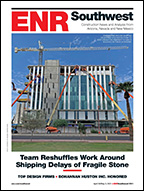Infrastructure marvels and structures in any period of history—from the Hoover Dam to the Washington Monument—often amaze us by their scale and technical innovation and all that is needed to build them. Yet, I wonder whether the structures we are creating today will stand the test of time and be viewed with the same admiration decades or centuries from now. We may be overlooking the importance of quality and aesthetics.

Because we are pressed for time and short of patience and skilled craft labor, aesthetics are often secondary. That must change if the structures being built today are to endure and serve as a window to our ingenuity and artistry.
My own house, a model home offered by the developer and built to specification at a set budget, is an example of the quality problems that compromise aesthetics. The concrete basement floor lacks a proper finish, and the floor slopes away from the drain—causing the basement to partially flood whenever there is a leak from the water heater. The basement’s concrete wall was not completed, leaving an unplanned construction joint that could become a constant source for seepage if the ground water level were to rise. Fine soil particles could enter behind a finished surface causing mildew growth and other problems. Unless the joint could be sealed from the outside, which at the time was impossible without undertaking a huge excavation behind the wall, sealing it from the inside would not help. The hydrostatic pressure behind the seal would cause it to fail.
Quality and aesthetics are compromised on major highway projects, too. If you pay close attention to the top and finished surfaces of cast-in-place single slope barriers (let alone any aesthetic grooving that may have been proposed or planned on the surface for decorative purposes or to break the monotony of a single slope), you will find that there are no neat lines, geometry or surfaces that are pleasing to the naked eye. Similarly, joint widths on precast concrete noise walls show no neat lines or uniformity due to the challenges of casting, erecting and assembling the panels. The same goes with retaining walls.
Art and Skill
Concrete finishing is an art and skill. Not many understand deeply enough the product and its behavior in various environments to be able to use the right mix and finishing techniques. The same is true of other traditional materials, such as stone, brick, masonry blocks, woodwork and glass.
More importantly, it takes personal pride in workmanship and patience to build structures that are works of art. The desire to accelerate projects and meet the demand for higher work volume does not lead to work that will be a lasting source of admiration.
To do that, we must begin with greater recognition of and higher pay for craftworkers—pay high enough to ensure quality of life. That will expand the talent pool and encourage creation of construction craft programs, including trade schools.
What’s more, we need to articulate the talent, skills and qualifications required to finish the work. Just think of what’s done in the restoration or expansion of historic structures, where brick, stone, wood or tile from a certain time period must be matched and the construction documents are developed in detail to not only specify material types but also aesthetic and finish quality.
The same could be done for specific elements of work on large infrastructure projects and in buildings so that they are aesthetically satisfying and leave a lasting impression.
There’s really a romance and excitement in the combination of design, construction and materials that work in harmony not only to fulfill a function such as providing shelter or facilitating transportation but also to elevate the spirits of the people who use them and enhance our shared civilization.
We must reinvigorate the tradition of training in the use of various construction materials through trade schools and more rigorous apprenticeship programs. We must ensure that we allow for adequate time to construct quality projects. And we must pay keen attention to details so our building and infrastructure projects can be admired for generations to come.



Post a comment to this article
Report Abusive Comment